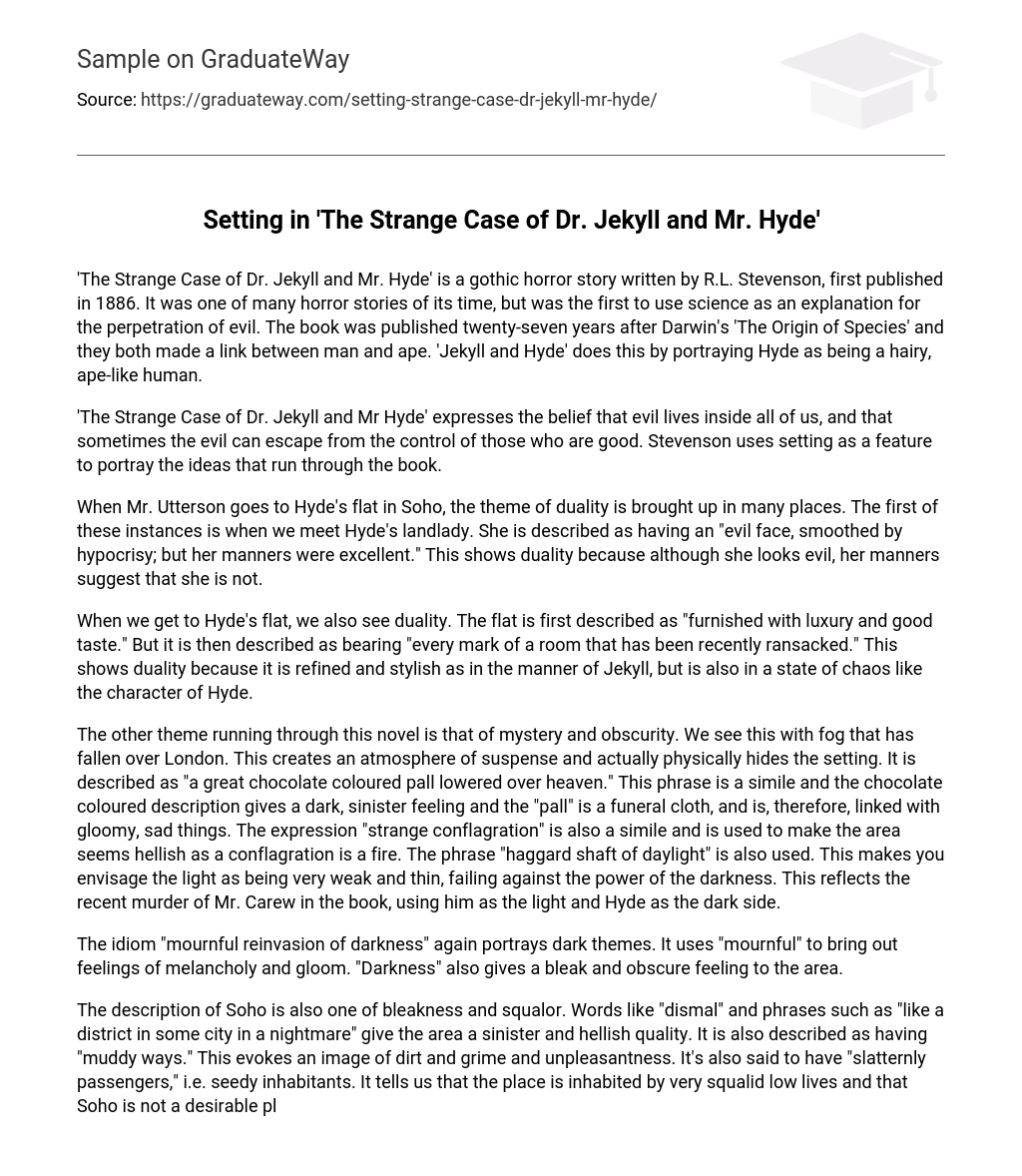‘The Strange Case of Dr. Jekyll and Mr. Hyde’ is a gothic horror story written by R.L. Stevenson, first published in 1886. It was the first of its kind to utilize scientific reasoning as an explanation for the manifestation of malevolence, amidst multiple contemporary horror tales. Published twenty-seven years subsequent to Darwin’s influential piece, ‘The Origin of Species,’ both works establish a connection between humanity and primates. In ‘Jekyll and Hyde,’ this connection is depicted through the portrayal of Hyde as a beastly, hairy, and simian-like being.
‘The Strange Case of Dr. Jekyll and Mr Hyde’ explores the concept that every individual carries a darkness within, which can occasionally break free from the confines of their virtuous nature. Stevenson employs the setting effectively to illustrate the overarching themes present throughout the novel.
During Mr. Utterson’s visit to Hyde’s flat in Soho, the concept of duality emerges in several instances. The initial occurrence arises upon encountering Hyde’s landlady, who possesses an “evil face, smoothed by hypocrisy; but her manners were excellent.” This illustrates duality as her appearance suggests wickedness while her behavior implies otherwise.
Upon arriving at Hyde’s flat, we encounter duality. Initially, the flat is depicted as being adorned with opulence and sophistication. However, it is subsequently depicted as displaying signs of recent turmoil and disorder. This dichotomy symbolizes the refined and elegant nature of Jekyll, juxtaposed with the chaotic essence of Hyde.
In this novel, there is a recurring theme of mystery and obscurity. This is evident through the presence of fog that engulfs London, creating an atmosphere of suspense and physically concealing the surroundings. The fog is described as “a great chocolate coloured pall lowered over heaven,” using a simile to convey a dark and sinister feeling. The word “pall” implies a funeral cloth and associates the fog with gloomy and sad elements. Another simile used is “strange conflagration,” which paints the area as hellish, evoking the image of a fire. Additionally, the phrase “haggard shaft of daylight” conveys a weak and feeble light struggling against the power of darkness. This imagery corresponds to the recent murder of Mr. Carew in the book, where he represents the light and Hyde symbolizes the dark side.
The phrase “mournful reinvasion of darkness” represents somber aspects once more, invoking a sense of sadness and gloom. The utilization of “mournful” elicits feelings of melancholy, whereas “darkness” contributes to the desolate and enigmatic atmosphere.
The description of Soho is characterized by bleakness, squalor, and a sinister atmosphere. Words like “dismal” and phrases like “like a district in some city in a nightmare” contribute to the hellish nature of the area. Additionally, it is described as having “muddy ways,” evoking images of dirt and unpleasantness. The presence of “slatternly passengers” indicates that the place is inhabited by seedy individuals, emphasizing that Soho is not an attractive place to live. This description is juxtaposed with the portrayal of other areas in the novel, such as the street where Hyde’s House is first encountered. This street is depicted as “florid” and stands out in contrast to its dingy surroundings, showcasing the duality of London and aligning with the main theme of the book.
The theme of duality in the novel is exemplified in the depiction of Jekyll’s house. Initially, we see the house from Hyde’s perspective. Stevenson describes the street where Hyde lives as “shining out in contrast to its dingy neighbourhood.” In contrast, Hyde’s house is portrayed as a “sinister block of building,” with a door that is “blistered and distained.” This side of the house shows signs of neglect and squalor. However, Jekyll’s side of the house is completely different. It exudes “wealth and comfort.” Stevenson employs personification to help us visualize scenes in the book more easily.
The other houses on the street where Jekyll’s house is located are also described as handsome. This is another example of personification. Upon entering this house, Utterson experiences a comforting and welcoming atmosphere. The hall is described as “comfortable” and there is a warm fire, creating a cozy and inviting environment. However, as the plot takes a sinister turn, the atmosphere of the area is described in a completely different way. While making his way to Jekyll’s house, Utterson encounters wild, cold weather that is described as having an ethereal and delicate quality, with the wind even causing blood to fleck his face.
Stevenson utilizes animalistic descriptions to prompt us to perceive the weather during this time as resembling a wild creature, possibly akin to Hyde. Furthermore, the fact that London is now “deserted” evokes a sense of fear as it raises questions regarding the reason behind everyone in a typically bustling city seeking refuge indoors. The fire within the house has also undergone a transformation in its appearance. It has grown significantly larger, emanating an aura akin to that of hell. Additionally, the servants are likened to “a flock of sheep,” highlighting their vulnerability and powerlessness in the face of the formidable predator that is Hyde.
However, Stevenson suggests that the house, despite its grandeur, contains an element of darkness and mystery. This could indicate that the house serves as a reflection of its inhabitant’s personality. The positive description of Jekyll’s half contrasts with Hyde’s, yet there remains a sense that neither fully reveals their true nature.
Stevenson effectively utilizes the setting in ‘The Strange Case of Dr. Jekyll and Mr. Hyde’ to convey the theme of duality.





